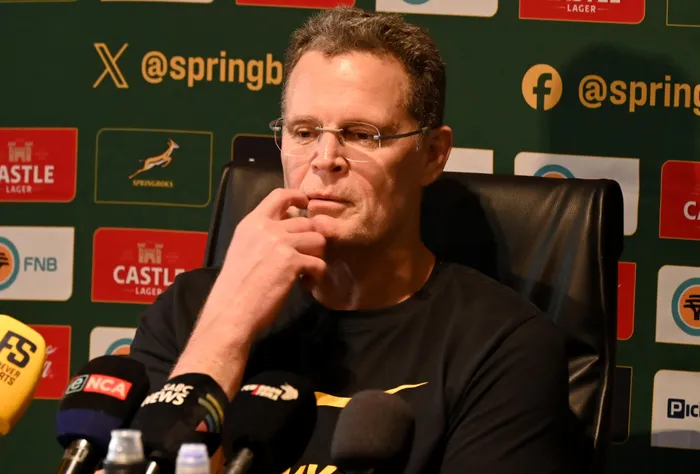Return of long throw-ins and the Wallabies beating the Springboks not on my 2025 sports bingo card
Tackling Goliath

Springbok coach Rassie Erasmus and his team may have to go back to basics to fix their current problems. Photo: Ayanda Ndamane Independent Media
Image: Ayanda Ndamane Independent Media
There are two things I didn’t have on my 2025 sports bingo card.
The one is definitely the reemergence of the long throw-in in the English Premier League, a throwback play that was once reserved for bottom-half teams to bully the big teams’ prima donnas in their penalty area.
Rory Delap even had a ball-boy dry the ball with a towel before the throw-in during those cold and rainy nights in Stoke …
There’s something beautifully unrefined about a long throw-in. It’s unapologetically agricultural, designed for teams who can’t find a goal with beautiful, intricate passing. In an era of false nines, xG metrics, and inverted full-backs, the long throw is the sporting equivalent of putting a steak on a plate without any garnish – it’s primal, no-nonsense, and strangely effective.
In the middle to late 2000s, Stoke City right-back Delap used to launch those long throw-ins flat and hard, with the trajectory and power making it very hard to defend against.
In 2025, it’s back, with many of the big teams with multi-million-pound players using it as a tactic. Tottenham and Arsenal, to name a few, used it as a weapon on the opening weekend, launching the ball from the advertising hoardings straight into the six-yard box to create some havoc.
The other one is the reemergence of the Wallabies as a Test threat before beating the Springboks at Ellis Park for the first time since 1963.
After 19 minutes of rugby, with the Boks 22-0 in the lead, it looked like the Wallabies were going to leave Ellis Park in a closed casket, beaten beyond recognition. But they rose from the dead like WWE icon The Undertaker, taking Rassie Erasmus’ team by the throat and giving them one hell of a chokeslam. A
nd, just like the long throw-in, they weren’t subtle about it either.
The great All Black and Springbok teams of the last two decades share one common trait. Both were masters at executing the basics, while the Wallabies have fallen behind in the Southern Hemisphere pecking order because they tried to be too cute with the calibre of players at their disposal.
It was there for all to see under Eddie Jones at the 2023 World Cup in France. His tenure was a masterclass in overthinking, with buzzwords, judo camps, and no real plan to solidify the team’s spine.
But under Joe Schmidt, they have become rugby’s version of the Rory Delap doctrine: direct, intense and designed to make the opposition deeply uncomfortable.
Competing hard and targeting the Boks at lineout time and at the breakdown, before counterattacking with pace and verve – those things weren’t exactly rocket science.
The Wallabies executed brilliantly in the second half at Ellis Park, causing the same sort of panic in the Springbok ranks as a long throw-in in the box.
The Wallabies’ win also exposed some of the shortcomings in the Springboks’ ranks. The wins over the Barbarians, Italy and Georgia papered over many cracks that currently exist in the Bok armour.
Their line-outs, attacking breakdown and transition defence have been a problem this year. While it was diagnosed in the first game against Italy, the Wallabies exposed it as a problem that may require major surgery going forward.
While the Springboks see themselves as the leaders in rugby innovation – and rightly so – it may be time to go back to basics and the “long throw-in” themselves when they face the Wallabies again in Cape Town.
Something is currently not clicking within their system, and I’m certainly too dumb to actually point a finger at what is going wrong in the lineouts, why players are isolated in the carry and why they are so exposed at the back from counterattacks.
What I do know is that sometimes simple is better. Sometimes a good old long throw-in is better than an elegant move down the middle. The Wallabies showed that at Ellis Park, and maybe the Boks must be humble and do the same.
Related Topics: